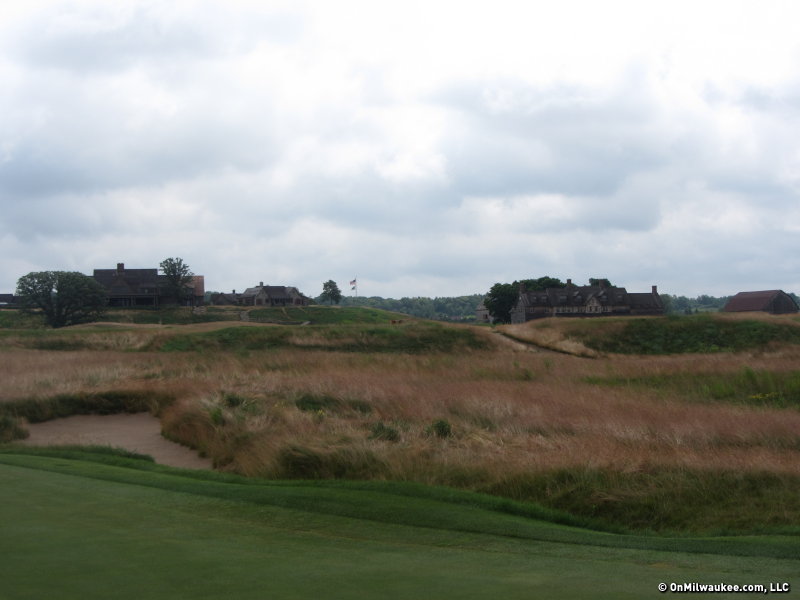TOWN OF ERIN – Erin Hills was famous before it was born, a glacier-cut piece of land 35 miles northwest of Milwaukee that was awarded one of America’s national golf championships years before it opened in 2006. Then, before the course hosted that championship – the 2008 Women’s Amateur Public Links – the United States Golf Association awarded it the 2011 U.S. Amateur, the most prestigious amateur tournament in the country.
Before that tournament was held, the USGA presented the course its crown jewel, the U.S. Open.
"It’s like nothing I have ever seen in our state," Edgerton native and Madison resident Steve Stricker told the USGA back in 2008.
It’s a sentiment echoed by Erin Hills Director of Golf Rich Tock, who started out as a PGA assistant at Milwaukee Country Club nearly four decades ago.
Before coming to Erin Hills in 2009, Tock spent 33 years as a head professional, first at South Hills Golf and Country Club in Fond du Lac and then at Ozaukee Country Club in Mequon. He has seen and played most, if not all, of the state’s premier golf courses.
"It’s just different," Tock said. "There’s nothing like this."
Because of the early anointment of greatness by the USGA, the course has always been a must-play. Founder Bob Lang would often rock back in a chair in the pub and smile, talking about the number of players from around the world that had already traversed the venue designed by Dr. Michael Hurdzan, Dana Fry and Ron Whitten.
But now, seven years after it opened and with two national championships already in the books, the course is truly growing up.
Under the leadership of owner Andy Ziegler, the Artisan Partners Limited Partnership co-founder and CEO who purchased Erin Hills in the fall of 2009, along with superintendent Zach Reineking, the course is now fulfilling the vision Lang, its architects and the USGA saw nearly a decade ago.
"Since 2011 we’ve continued a very aggressive process of eliminating all the different grasses in the fairway so we have just a pure strand of fine fescue," Tock said. "The greens and the tees are bent grass and have been in beautiful condition since day one. The greens roll, on a day to day basis, at about 11 to 11.5 on the Stimpmeter. For the non-golfer, that means that the speed of the greens are consistent and consistently fast.
"We put a full court press on the native areas. We took down 325 trees and a lot of the native areas were just rocks and dirt and weeds, so for the past three and a half years we’ve sprayed for the weeds and planted fine fescue of which now is about 95 percent grown in. Fine fescue is a pretty thick grass the first couple years and then it starts to thin out and get wispy. We’re on our third or fourth year right now so a lot of the areas are starting to go in that direction. There are still a few areas that are still pretty thick, but with the caddies you don’t lose a ball. They’ll be able to find it. It might be a little difficult getting out of it but not bad. That’s a continuing process."
To get here, some changes had to be made. One of the first was the elimination of carts, to help preserve the fescue fairways. It has been walking only since 2010, and players are encouraged to utilize the caddie program as the loopers not only know the course, but will aid in finding wayward tee shots into the maturing long fescue off the fairways.
The course itself has undergone changes over the years, too. The first fairway was altered to assist in conditioning. Bunkers have been added on holes 3, 7, 14 and 18. Tees have been added to holes 5, 8 and 16. The 10th hole, once a quirky par 5, is now a best of a par 4 that tops out at over 500 yards. More changes are scheduled as well, beginning this fall with the construction of new third green.
But now, heading into the late summer and fall of 2013, Erin Hills’ personality is showing, both in how it plays and how it looks.
"In June, the fescue turns into a nice purple haze when it blows in the wind," Tock said. "Then in about mid-July it starts to go dormant and it turns into that light brown color."
Wind will always be the player’s enemy at Erin Hills, a golf course that has the look of a links-style venue but requires artful aerial plays. Where playing the ground comes in handy is off the tee, as the fescue fairways play hard and fast over the mounds and down the angles. Hit the fairway, and you’ll get tour-quality roll.
Precision is required everywhere, however. The fairways feel wide, but be sure to hit them because the fescue takes hitting a green in regulation out of play. Approach shots are varied, playing into beautiful – but challenging – green complexes. Distance, and wind, control, is a must.
If you miss a green, but remain out of a hazard, the course again presents links-style shot options. You can play your recovery along the ground, using the quick fescue collection areas for a variety of plays.
Make no mistake – Erin Hill is a hard golf course – but if you play from the right set of tees, you’ll find yourself with an opportunity to play well. On the scorecard, the black tees (the tips) are listed at 7,823 yards, but players can tee it up from the blue (7,234), green (6,756), white (6,423) or the 6,990-yard blue/green combination. There are forward white tees (6,423) and the reds (5,123) or a combination of the two at 5,889 yards.
I’ve played Erin Hills as a 20-handicapper and at points in-between down to a 12; have played it straight through from the blue’s, the green’s, and the combination green and white’s, and I have to stress that making the right tee choice is imperative. The golf course will test you enough. If you’re going to make the time and financial investment to play – be sure you can enjoy it.
Erin Hills is not just meant for a quick in-and-out round, however. It’s a total golf experience, a day long retreat that is meant to be enjoyed. Book an afternoon tee time, but get there early for food and to utilize the 25 acre driving range that has 12 target greens. Get a feel for the green speed on the putting green. Then, after your round, enjoy dinner and a beverage on the patio that has gas lit fire pits to help warm the spirit. The pub is open late for those who live nearby or who are staying overnight in one of the three cottages or the lodge.
If you’re looking to play in 2013 however, book now, as the course is closing in October and the tee sheet is near capacity.
After all, as Tock says, "It’s become a worldwide destination."
Be sure to take advantage.
Tock also gave us some insights for the players that will be ready to tee it up at Erin Hills:
What are the holes where a scratch player will trouble making par playing from near the tips? We have five holes out there that are par 4’s over 500 yards, but No. 10 would be the toughest. No. 8 would be probably second (toughest) and then probably No. 18, in terms of trying to make a par.
What are the holes where a double-digit handicap can make par? That would be 1, 2, 5, 11, 15 – those holes you’d have a chance at making par. Now, you could also make a double bogey, but you’d have a chance at making a par. The golf course is just not easy.
What is the one shot you need to have at Erin Hills? The straight tee ball. Number one, if you miss a fairway the fescue is very long and thick so you can’t get to the green if you miss a fairway. You’re not going to get home in two, so you will not putt for birdie. So right away you’re behind the eight ball and you have to scramble. You have to put it in the fairway. And if you put it in the fairway you’re going to get an extra 40 yards because they’re firm and fast. It’s a tough game but it’s a lot easier playing from the short grass after your first shot.
Erin Hills’ topography lends itself to memorable vistas and shots – what is your favorite? That’s a tough question. That’s a very tough question. Number 9, the par three, is a beautiful par 3. You can make a three or a 10. When I walk to the ninth tee I say ‘well, this is the shortest par 5 in the state.’ That’s my comment to the guys I’m playing with. If you m is the green, you almost always make four or five. So that’s a beautiful tee shot. The 18th tee shot with the hole 675 yards long and the lodge and the whole village in the background and Holy hill behind that. That’s a pretty special tee shot on a sunny day.
Jim Owczarski is an award-winning sports journalist and comes to Milwaukee by way of the Chicago Sun-Times Media Network.
A three-year Wisconsin resident who has considered Milwaukee a second home for the better part of seven years, he brings to the market experience covering nearly all major and college sports.
To this point in his career, he has been awarded six national Associated Press Sports Editors awards for investigative reporting, feature writing, breaking news and projects. He is also a four-time nominee for the prestigious Peter J. Lisagor Awards for Exemplary Journalism, presented by the Chicago Headline Club, and is a two-time winner for Best Sports Story. He has also won numerous other Illinois Press Association, Illinois Associated Press and Northern Illinois Newspaper Association awards.
Jim's career started in earnest as a North Central College (Naperville, Ill.) senior in 2002 when he received a Richter Fellowship to cover the Chicago White Sox in spring training. He was hired by the Naperville Sun in 2003 and moved on to the Aurora Beacon News in 2007 before joining OnMilwaukee.com.
In that time, he has covered the events, news and personalities that make up the PGA Tour, LPGA Tour, Major League Baseball, the National Football League, the National Hockey League, NCAA football, baseball and men's and women's basketball as well as boxing, mixed martial arts and various U.S. Olympic teams.
Golf aficionados who venture into Illinois have also read Jim in GOLF Chicago Magazine as well as the Chicago District Golfer and Illinois Golfer magazines.







